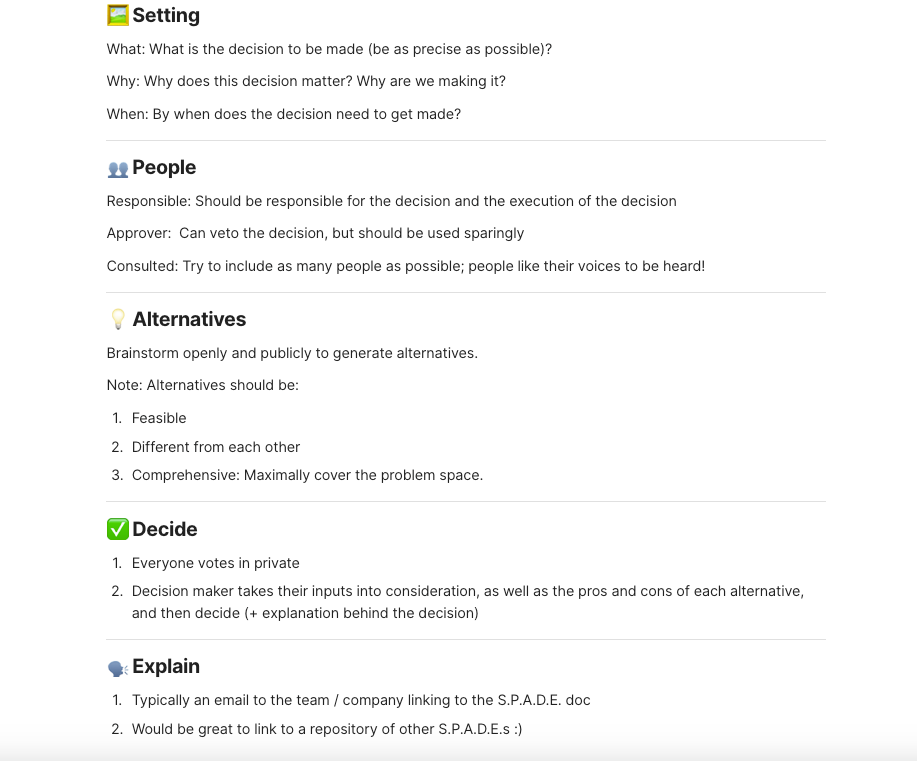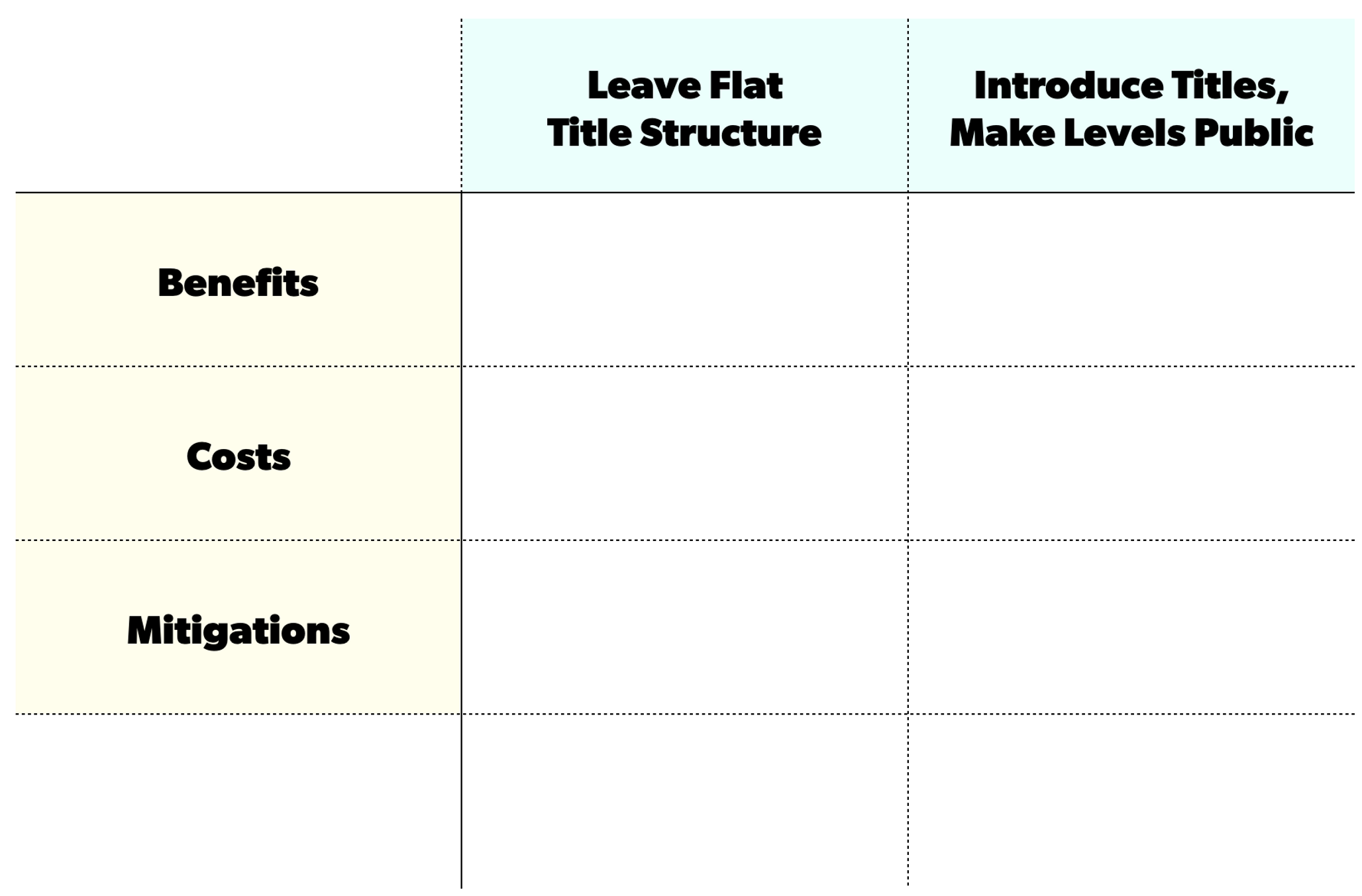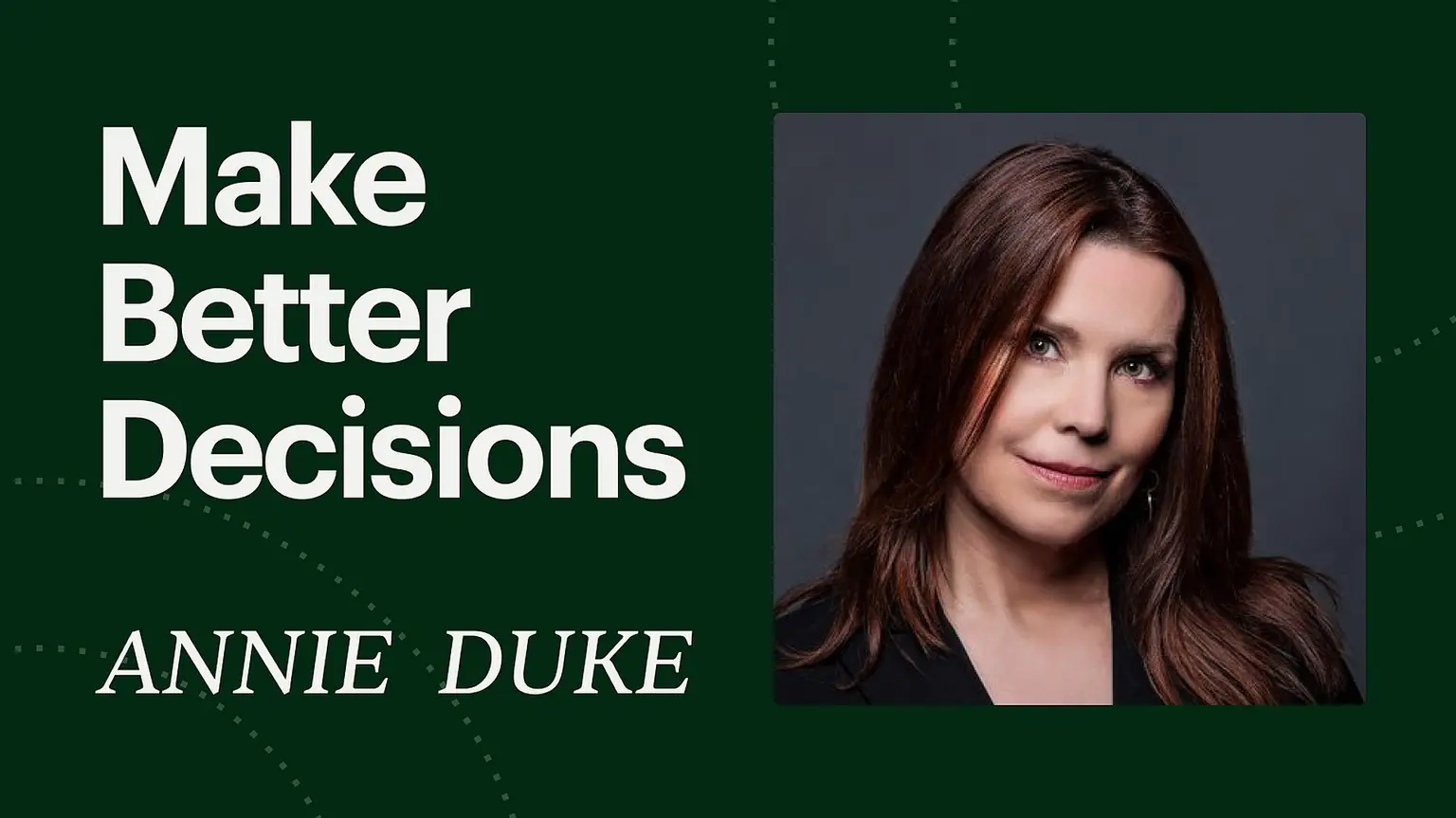Projects that grind to a halt as the rank-and-file employees wait for all the higher ups to “sign off.” Bold ideas that never get greenlit. New initiatives that never make it out the door. Hours of work that never see the light of day. We all recognize these symptoms of an organization that’s more sluggish than speedy, more “don’t make any wrong moves,” than “move fast and break things.”
No one starts out intending to move slowly. Early-stage founders all seem to have a bias in the other direction — moving as quickly as possible — so decision making speed may not seem like an area to keep a careful eye on at first.
But as scale takes over, the scene starts to change — imperceptible in the day-to-day, but a dramatic difference in a few years. Fears of failure creep in. Org charts become more complex as more employees join. Office politics take hold. The choices seem to become bigger, with more and more on the line. Decision fatigue wears managers out. Indecision paralyzes executives.
That’s why we hear so many leadership teams struggling with variations of: Why can’t my team move more quickly? Why can't we make decisions faster?
There’s no mystery as to why decision making is important and why speed matters — it's figuring out how to go faster that isn’t all that straightforward. Very few resources focus on the brass tacks of how to actually push your team members to be more decisive and cultivate a culture centered around speed.
To that end, we’ve put together a guide full of tactical advice on how to speed up decision making at your company. Whether you’re trying to fix a decision making process that’s slowed as you’ve scaled, or you’re looking to combat indecisive approaches and build in speedy habits right from the start, there’s tons of more-concrete insights that you can put to use right away, increasing the likelihood that you'll be make better decisions, faster.
1. Start by looking out for these signs that you’re moving slowly.
You don’t want to pursue speed for speed’s sake. In her guide for helping marketing teams move faster, Mutiny co-founder and CEO Jaleh Rezaei shared a helpful definition that you can frame up for your team as the objective they should keep their eyes on: “Real speed is moving fast towards impact and learning. It’s moving as fast as you can towards the most important thing.”
To figure out team if your team is learning quickly enough, see if you’ve noticed any of these warning signs in the last few months:
- Shipping delays: Pay close attention to the timeline between ideas being batted around to being out in the world. If two weeks go by without a launch of some kind, that's a red flag. “If we talk about launching an event program, we better have an MVP event within two weeks — something’s got to be live,” says Rezaei.
- Short goal horizon: Goals focused too far in the future can prevent driving at the right speed week-to-week. “At the end of the quarter, we’ll have 5 new customers” needs to be matched by “In three weeks we’ll have 25 demos” type of outcomes. “If you have weekly goals, you have 12x more at-bats than someone who's only lifting their head up and evaluating quarterly,” she says.
- Lack of learning: Staring down the same challenges month after month isn’t a good sign. As a manager, you want a steady stream of feedback — and for your team's problem solving skills to stay sharp. “If you ask, ‘What do we know this week that we didn’t know last week?’ there better be a new answer to that question,” she says.
Fast teams are always solving fresh problems.
2. Figure out when to go fast and when to go slow.
As decision science expert (and former poker pro) Annie Duke points out, time spent choosing between options adds up — not just in decision fatigue, but in literal hours. For example, the time the average person spends deciding what to eat, watch, and wear adds up to 250-275 hours per year. Indecision on low-stakes tradeoffs like these can be reduced without incurring dramatic costs.
“Many feel that adhering to a decision making process can slow you down. But knowing when it’s okay to save time is part of a good decision process. Assess the consequences and the reversibility of the decision if you get it really wrong,” she says. “A good framing is to ask, ‘If I pick this option, what’s the cost of quitting?’ The lower the cost of changing course, the faster you can go as a decision maker.”
When researchers at McKinsey examined decision making at Fortune 500 companies, they didn't find a tradeoff between speed and effectiveness. In fact, companies that took more calculated risks at a faster pace tended to perform better than those stuck in multi-month deliberations.
Of course, there’s a difference between mulling your options when choosing a new executive and being overly indecisive when hiring an intern. Or take the work of developing minimum viable products — talking to customers, squashing bugs and tinkering on new features can be done quickly, but stepping back to identify what kind of product you’ll build in the first place is an area worth spending more time on.
Another technique for becoming more decisive is to apply “the happiness test.” Ask if the outcome of your decision — good or bad — will likely have a significant effect on your happiness in a year. If your intuition is no, you can speed up. Now repeat the exercise, re-assessing the outcome and potential consequences if you shrink the horizon to one month and then one week. The shorter the time period for which your answer is “No, it won’t much affect my happiness,” the more you can trade off accuracy in favor of saving time — replacing indecision with decisive speed.
When the cost to quit is low, you can go fast. When you can exercise multiple options in parallel, you can go even faster.
3. Pick a decision-making framework — and stick to it.
Every choice you face is a unique situation, but going with the bias of your gut or the simplicity of a pro con list usually isn't the best approach as you weigh different options. Instead, there are useful frameworks for making decisions that you can use to “automate” your process, unpack the bias in your assumptions, reduce emotions and identify risks in a more consistent fashion.
“Back at Instagram, I found it didn't really matter which decision-making framework we used, just that we picked one and then everyone knew what algorithm we were going to apply to everything,” says James Everingham (currently co-founder and SVP of Engineering at Lightspark).
There are countless approaches that will help your team become more decisive, but we’ll highlight a few of our favorites for driving clarity in your deliberations, reducing decision fatigue and boosting confidence in your decisions below:
For thinking through particularly thorny decisions, use the SPADE framework:
The “Setting, People, Alternatives, Decide and Explain” approach was pioneered by Gokul Rajaram and his former Square colleague Jeff Kolovson, and you can read it in full here. (Also, make implementation even easier by using this toolkit of templates Rajaram developed to help capture your thinking.) This one is for the times you've faced the hard decisions with big consequences, not for selecting a flavor of kombucha, Rajaram jokes.

To improve alignment, collect feedback and reduce stress, use the “Xanax for decision making” matrix.
Gil Shklarski shared this framework with us several years ago, and it's a classic for a reason. This approach divides decisions into two categories (irreversible and reversible decisions), charting the benefits, costs and mitigations of each choice, outlining different perspectives. Unlike SPADE, this framework focuses on reducing the emotion of situations that fall into the reversible decisions category — where being indecisive can really add up and slow you down. “People will expect and accept scrutiny and overhead for Type 1 decisions," says Shklarski (formerly CTO at Flatiron Health, now at Thirty Madison). "Streamlining Type 2 decisions helps managers make team members happy, allowing things to be accomplished without the usual stress.”

To achieve consensus and implement plans as fast as possible, use the RACI model to identify and assign decision makers.
Specifically focus on who is responsible, accountable, consulted and informed before every decision.
Read more on how Instagram’s engineering org implemented this approach to boost transparency.
To evaluate the strength of an idea and see if it’ll have staying power, use the PR/FAQ approach from Amazon as you identify key assumptions and risks.
Amazon has popularized the notion of working backwards, and the company’s Press Release/Frequently Asked Questions (PR/FAQ) approach is particularly steal-worthy. Former Amazon execs Colin Bryar and Bill Carr shared an inside look at the process with us a few years ago. Writing up a press release normally comes at the end of the launch process, but instead, try starting by articulating the problem you’re trying to solve and describing the customer experience you’d like to build. Write it all up in a doc, adding on the FAQs that outline all challenges you’ll face and the solutions that might work. This not only sharpens your thinking, but makes the tradeoffs more clear for decision makers. “As you're making decisions, the questions to think through are, is it big enough to move the needle? And not just next quarter, but long-term?” say Bryar and Carr.

If you like Annie Duke's advice, consider taking her Make Better Decisions course on Maven
4. Make the decision (and your goals) smaller.
Annie Duke puts this challenge to decision makers at startups: “Is there a way to make this a smaller decision than the one you are considering? It’s about realizing that, in some sense, you do have control over how big the decision is.”
Continually ask: What's the smallest version of this that we can do at the least cost to us? Whether you have 3, 30 or 3000 employees, you should always bring that mentality when making decisions.
As Mutiny’s Jaleh Rezaei observes, this thinking is key to building momentum. When you try to push a big box, it’s difficult — until you get it to start moving, then it gets much easier to push. “Static friction is a lot higher than kinetic friction. Once it’s set in motion, everything is easier,” she says.
Applying this insight to your goal setting and decision making process will help you avoid what Rezaei calls our natural bias to "stay in the basement." A motion goal could be securing a customer discovery call for a new product idea with one prospect in your first week, for example. “It’s easy to think we haven’t done any analysis, we haven’t built anything around it. How could we possibly start selling it? But it doesn’t actually matter if you hit the goal. Making the choice to move forward forces you out of the basement and helps you get real feedback. It helps you figure out where you’re experiencing the most friction and what will require the most problem solving.”
5. Ask these questions to “challenge the when” and move faster.
It’s easy to get caught up in what was decided or the resulting outcome. But Upstart’s Dave Girouard finds there’s one aspect of the decision making process that’s frequently overlooked (and given that he penned one of our most widely-read articles on how to make speed as a habit, his perspective is one that’s particularly worth heeding here).
“I’m always shocked by how many plans and action items come out of meetings without being assigned due dates. Even when dates are assigned, they’re often based on half-baked intuition about how long the task should take. It’s not that everything needs to be done now, but for items on your critical path, it’s always useful to challenge the due date,” he says.
“WHEN a decision is made is much more important than WHAT decision is made. Deciding on when a decision will be made from the start is a profound, powerful change that will speed everything up,” he says.
“When you feel things start to slow down, you have to keep asking questions to challenge the when. Questions are your best weapon against inertia.” Add these into your rotation of questions managers should ask regularly to practice challenging the when:
- Why can't this be done sooner? Can you help me understand why something would take so long? Is there any way we can help or make it go faster?
You don’t have to be militant about it, just consistently respond that today is better than tomorrow, that right now is better than six hours from now. The candle is always burning. You need leadership to feel and infuse every discussion with that kind of urgency.
6. Screen for speed in hiring.
Of course, it will be easier to move faster with team members who are hardwired with a need for speed. One easy, yet often underutilized strategy is to add interview questions that focus on speed to all your hiring loops. (This is especially important as you decide whether or not to hire folks from a “BigCo” background who might not be as used to the fast pace of an early-stage startup — we recommend reading more on spotting candidates who can “scale down” their leadership.)
Given her focus on moving quickly, Mutiny’s Jaleh Rezaei has sharpened her ability to evaluate a candidate’s dedication to speed.
“We always do case-based interviews. I ask a lot of questions like, ‘We have an objective to get to 1,000,000 blog subscribers in 12 months. How do we do that?’ Or ‘We want to come up with a new scalable event model that’s going to help us hit the outcome of 5,000 new customers by the end of the year. How do we do that?’”
Here’s the perspective she’s looking for in their answers: “How scrappy are their ideas? Can they quickly put pen to paper and ideate with confidence? Obviously they will have to research things and they don’t have a ton of context, but if every answer always starts and ends with, ‘I would talk to other people' or 'I would do research on this,’ that’s an early indicator that this is someone that’s prone to going into the basement,” she says.
Dig deeper by shortening the timeline even further. “I’ll say, ‘That’s a great suggestion, now I want you to do it in one day. How would you get this out tomorrow?’ It’s hard and uncomfortable to do new things, which tempts us to spend months of planning and creation in isolation to get it right. But you don’t learn anything in the basement.”
Faced with a particularly time-constrained decision? We recommend this read on how to run your war room most effectively. Other good reads on boosting your confidence in your decision making process include how Adobe’s Director of Product Marketing navigates decision fatigue and the paradox of choice and why it’s sometimes in your best interest to trust your intuition and gut.
